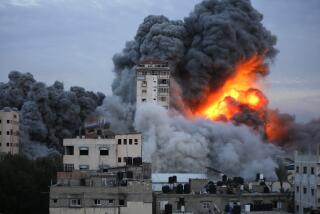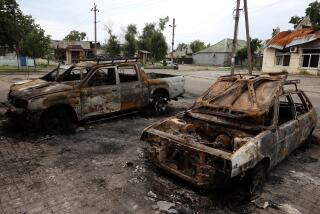Iraqi Scud Chemical Capability Is Questioned : Weapons: Analysts don’t believe Baghdad has the technology for the use of such warheads.
- Share via
The Iraqi military is not believed to have the technology necessary to carry out an effective attack with Scud missiles armed with chemical warheads, and it is unlikely to use such warheads against either Israel or Saudi Arabia, military analysts said Thursday.
In particular, the Iraqis do not appear capable of detonating the chemical warheads above the ground with the precision needed for adequate dispersal of the deadly nerve gases, and the country’s jury-rigged versions of the Soviet Scuds can carry so little of the chemical agents that they would not represent a severe threat.
“Against civilian population centers, the problem with a terror weapon that doesn’t work very well . . . is that once you use it, it doesn’t scare people any more,” said Brad Roberts of the Center for Strategic and International Studies in Washington. “The terror effect is only in holding back the weapon (and threatening people with it), not in using it.”
The threat of chemical warheads has been raised repeatedly as Iraq has aimed nearly two dozen Scuds at Israel and Saudi Arabia. With each attack, citizens and soldiers have been required to don gas masks, adding to fears.
While Iraq appears capable of surprising the allies with its military prowess--and no one can rule out categorically the prospect of Iraq possessing some secret missile technology--most analysts now believe that the fear of chemically armed Scuds is largely unfounded.
“They would like to have us believe that they have a hidden stockpile (of chemical warheads) that they could rain down on the region,” Roberts said. “But I don’t believe they have any left because they never had very many to start with.”
The experts agreed that the situation is quite different when it comes to using chemical warfare in ground battles. Iraq already has demonstrated its ability to spray nerve gas and disperse it in artillery shells.
“But there, too, people have overstated the problem,” Roberts said. “Iraq’s modest arsenal of chemical weapons has been reduced significantly, and their ability to produce new weapons has been eliminated” by allied bombing, he said, referring to reports from the U.S. military.
“I would anticipate their use of chemical weapons, and I would anticipate American deaths,” Roberts said, “but I anticipate it is a strategy that would be short-lived and for which our defenses are adequate.”
The primary factor militating against the use of chemical warheads on Scuds is the missile’s inherent inaccuracy. The Scud-Bs originally provided to Iraq by the Soviet Union were inaccurate, Roberts said, “but the extended-range Scuds, which are the source of the threat, have that problem in spades.”
The Scud-B is a 37-foot-long, liquid-fueled rocket that carries an 1,800-pound warhead a maximum distance of about 186 miles. The need for a longer-range missile arose during Iran’s war with Iraq. Baghdad lies within 200 miles of the country’s border with Iraq, making it a potential target for Scud-Bs owned by Iran.
But Tehran lies much farther from the border, placing it out of range of Scud-Bs. Iraq’s military thus launched a crash program to upgrade the Scud-B so that it had greater range. “There are only two ways to increase the range of a missile: give it more fuel or decrease the size of the warhead,” says analyst Janne E. Nolan of the Brookings Institution.
Iraq did both, eventually launching 189 missiles against Iranian cities. All carried conventional explosive warheads.
Ironically, most of the information about how they did it comes from Iranian experts who were able to examine unexploded missiles that landed in Tehran. “Their experts believe that Iraq cannibalized three Soviet-supplied Scud-B missiles to produce two Al Husseins (the Iranian name for the extended-range missile),” said W. Seth Carus of the Washington Institute for Near East Policy.
In essence, the Iraqis opened one of the Scud-Bs, removed the fuel and oxidizer tanks, cut off their ends, and cut the tanks in half, Carus said. The fuel and oxidizer tanks of the remaining two missiles were each cut in half and the severed sections inserted in the middle, increasing the overall length of the missile by about four feet.
A new skin and framework was then constructed to cover the added length. Overall, the process was very similar to building a stretch limousine from a conventional car. This enabled them to increase the fuel load from about 4 tons to just over 5 tons.
The size of the payload was also reduced to about 420 pounds. With these modifications, the missile was able to travel as far as 550 miles, far enough to reach Tehran--or any city in Israel. This meant a warhead could carry only about 270 pounds of a chemical agent, too little to have much effect. The amount is low because one-third of such a warhead’s weight is given to explosives needed to disperse the agent.
The Iraqis’ key error was in retaining the Scud’s guidance system. “Accuracy is inversely related to the distance a ballistic missile must travel,” Nolan said. When the Iraqis doubled the range of the Scud, they thus reduced its accuracy by half.
The accuracy was further reduced by poor workmanship, Carus said. “The welds on the frame were of poor quality and probably reduced the aerodynamic stability of the missile,” he said. In fact, some of the Al Husseins are known to have tumbled wildly in flight.
That tendency would be reinforced if the missile carried a chemical warhead, Roberts said. Because all of the chemical warfare agents available to Iraq are liquids, they can shift around in the warhead, further decreasing stability--the so-called “slosh factor,” he said.
That inaccuracy precludes military use of chemical warheads, the experts agreed. For chemical warfare to be effective, the missiles or artillery shells must lay down a tight pattern of shells or warheads to get a series of overlapping explosions that produce a high concentration of the agent, said Lora Lumpe of the Federation of American Scientists.
The Scuds are simply incapable of doing that, she added.
Furthermore, the warheads must be exploded at about 100 feet above the ground so that the chemical agent is effectively dispersed. If it explodes closer to the ground, it produces only a pool of the chemical on the ground that is dangerous only if someone goes near it, “and no one is going to do that,” Lumpe said.
If it explodes above 100 feet, the agent will be dispersed so much that it will be ineffective.
“We’ve seen no evidence that they have the technology to try to fuse it to explode above the ground,” Roberts said.
Raytheon, the manufacturer of the Patriot anti-missile missile, is working on a new warhead for it that will more effectively destroy the nerve gas in an incoming chemical warhead, but the new system is not expected to be ready for use for at least five years.
ADDING RANGE TO IRAQ’S SCUD Scud missiles manufactured by the Soviets for Iraq have limited range. Iraq decided to extend the range of some missiles by altering them. By reducing the payload and increasing the amount of fuel in the Scuds, the Iraqis effectively double the range of the missiles. 1. To increase fuel capacity, they cannibalize one Scud, opening it up and cutting its fuel and oxidizer tanks in half 2. Those segments are then inserted into the fuel and oxidizer tanks of two other missiles and the body is lengthened to accomodate them.
Example of how three short-range missiles are used to make two medium-range weapons.
More to Read
Sign up for Essential California
The most important California stories and recommendations in your inbox every morning.
You may occasionally receive promotional content from the Los Angeles Times.













